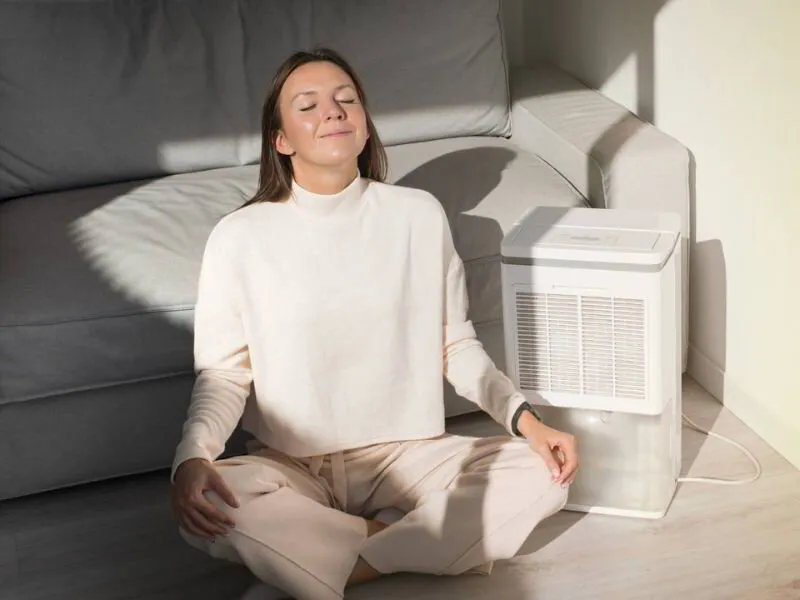Ever found yourself scratching your head, wondering why your trusty dehumidifier isn't collecting water like it used to?
You're not alone. This common household predicament has many American homeowners puzzled. But don't despair! There's a good chance the solution is simpler than you think.
We'll dive into the top reasons why your dehumidifier might have stopped doing its job and, more importantly, how to get it back on track.
By the end of this article, we guarantee that you'll be equipped with the knowledge to tackle this issue head-on like the home maintenance superstar you are!
What's Causing The Problem
Now, it's crucial to understand that a dehumidifier refusing to collect water is rarely due to a single, universal issue.
It's often the result of a complex interplay of various factors - think room temperature, humidity levels, or even the age of the appliance.
In the following sections, we'll delve into and demystify the most common causes behind your dehumidifier's lackluster performance.
Desiccant Dehumidifiers vs Compressor Dehumidifiers
Where your issue lies is strongly linked to what kind of dehumidifier you have.
A desiccant dehumidifier uses a moisture-absorbing material, commonly known as a desiccant, to pull excess moisture from the air.
It's typically lightweight, quiet, and effective at lower temperatures but can have issues if the desiccant material becomes oversaturated or loses its absorbing capabilities.
If you have a desiccant dehumidifier, your problem likely lies in this desiccant material or in any clogs that may have built up in the filter or the condenser.
On the other hand, a compressor dehumidifier, also referred to as a refrigerant dehumidifier, works by cooling air to condense out its moisture and then reheating it to room temperature.
With compressor dehumidifiers, your problem is more likely to be mechanical, such as a coolant leak or compressor failure.
Low Air Temperature
The ambient air temperature may be the most common culprit behind your dehumidifier's underperformance.
Dehumidifiers operate most effectively at room temperatures that are above 65 degrees Fahrenheit.
If the air in your room dips below this threshold, the coils in your dehumidifier might freeze up, preventing the unit from being able to extract moisture from the air.
This is because the refrigerant inside the dehumidifier is cooler than the surrounding air. When the air is too cold, the humidity in the air condenses too quickly and leaves you with frozen coils.
You can typically solve this issue by moving your unit to a warmer location or raising the room temperature.
However, if you live in a particularly chilly environment, you may want to consider investing in a dehumidifier designed specifically for low-temperature operations.
Not Enough Refrigerant Fluid
Just as your car needs gas to run, your dehumidifier requires a steady supply of refrigerant fluid to operate effectively.
This fluid is the cornerstone of the dehumidifying process—it cools down the unit's coils, transforming the moisture in the air from gas to liquid.
If your dehumidifier is low on this crucial refrigerant, it may result in inadequate cooling of the coils.
Consequently, the moisture in the air won't condense effectively into water droplets, causing your dehumidifier to collect less water or, in some cases, stop collecting water entirely.
If you suspect your dehumidifier's low performance is due to a refrigerant shortage, it's best to call a professional.
They can not only refill or replace the refrigerant but also check for any potential leaks that caused the problem in the first place.
Broken Compressor
The heart of your dehumidifier is its compressor—this mighty little engine compresses the refrigerant, making it hot and high-pressure before it gets sent to the cooling coils.
If this compressor is on the fritz, then you've got a problem. A faulty compressor means the refrigerant doesn't get compressed, which in turn means the coils don't cool down as they should.
Without that chill factor, the moisture in the air doesn't condense on the coils and drip into the collection bucket but instead remains as an unwelcome guest in your room's air.
Compressor-based issues require a high degree of technical expertise to fix. A professional can diagnose and fix this problem, restoring your dehumidifier to its best water-collecting.
Overuse
We all love a hard worker, but even the best of us need a break now and then.
This holds true for your dehumidifier as well. You see, incessantly running your dehumidifier can lead to fatigue of its components, causing them to wear out or malfunction over time.
It's like running a marathon without any training breaks—you're bound to hit a wall sooner or later.
This overuse can result in a number of issues, one of which could be your dehumidifier’s inability to collect water as efficiently or even at all.
The components responsible for condensing and collecting moisture - the compressor, the fan, the coils - all need their downtime to continue performing at their peak.
So, giving your dehumidifier periodic rests is essential, allowing it to cool down and recover.
If you think your dehumidifier might be a victim of overuse, try giving it a well-deserved break. If performance doesn't improve, it might be a sign of a deeper issue requiring professional attention.
Other Parts Of Your Dehumidifier
Every component of your dehumidifier has a vital role to play. It's an intricate dance of parts that work together to reduce humidity levels in your home.
If a part, be it a fan, a sensor, or an electronic control board, decides to take an unexpected break, the whole show can come to a grinding halt.
In such scenarios, it's important to seek help from a professional who can accurately diagnose and rectify the issue.
The Fan
The fan helps drive the dehumidification process as it circulates the air in the room, pushing it over the cooled coils where the magic of condensation takes place. Without that essential air movement, the moisture-filled air stalls, remaining untouched by the cooling coils.
So, if your dehumidifier seems to be on a water collection strike, it's worth checking if the fan motor and blades are operating as they should. If it's not, don’t panic—often, it's an issue that can be fixed by a professional.
The Sensor
Your dehumidifier's sensor plays an important role in getting your dehumidifier functioning properly. It measures the humidity levels in the room and signals when to start and stop the dehumidification process, ensuring your machine runs only when necessary.
However, if this sensor runs into any technical issues, it might misread the humidity level, causing your dehumidifier to take an unneeded break or continuously run without collecting enough moisture.
Preventing Future Problems
A dirty air filter is one of the common causes of water leaks in your AC system.
Here's why: your AC unit's air filter is responsible for keeping dust, dirt, and debris from entering your system. When the filter becomes clogged with dirt, it restricts the airflow to the evaporator coil.
This lack of warm air can cause the coil to freeze, and when it eventually melts, it can leak water.
🔧 How To Fix
To fix this, regularly replace your air filter based on the manufacturer's recommendations - typically every 60-90 days when your system is in use.
Doing so keeps your system running smoothly and avoids possible water leaks. What's more, a clean filter can increase the lifespan of your system and help maintain the quality of your indoor air, so changing your filter regularly really is a no-brainer.
Preventing Future Problems With Maintenance
Just as you may regularly service your cars and restart your device to keep it running smoothly, so too should you care for your dehumidifier through regular maintenance.
Start by cleaning and dusting your unit regularly to ensure optimal airflow. Make it a habit to check for any ice build-up or other visible irregularities.
And remember to give your dehumidifier its well-deserved breaks. This regular TLC can go a long way in extending the life of your dehumidifier and maintaining its efficiency.
Of course, whether you're a seasoned homeowner or have never walked into a hardware store, this can be a bit intimidating.
And here's where we come in. Air and Energy of NWFL doesn't just stop at fixing issues. We're committed to preventing them, too.
We offer routine maintenance checks to ensure your dehumidifier is in top-notch condition. If you live in Pensacola, FL, contact us today and get our services at your doorstep at a time that suits you.
Conclusion
Your dehumidifier is a complex machine, and like any other, it can experience hiccups from time to time.
Whether it's a refrigerant shortage, a broken compressor, overuse, or other faulty parts, there are numerous reasons why your trusty dehumidifier might stop collecting water.
But don't worry, it's not the end of the world—or even the end of your dehumidifier.
By understanding the potential issues, giving your dehumidifier the rest it needs, and ensuring regular maintenance, you can keep your home's humidity levels in a comfortable zone.
Our team at Air and Energy of NWFL is always here to help, whether for diagnosing and fixing a problem or for preventative check-ups.
Don't let those humidity levels creep up on you—give us a call today!
This article was written by:
Co-founder and Home Comfort Specialist






